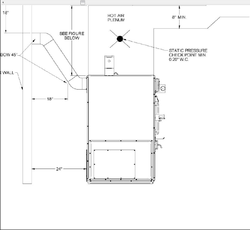Hello,
I have owned a PSG Caddy for the past two winters and recently had the plenum and some ducting rebuilt after moving the furnace to a different location in the basement.
Through much trial and error I have learned techniques to operate the furnace during the coldest winter months so that the house temperature tops out at around 68 degrees Fahrenheit; but, the process seems very labor-intensive and the early-morning temperature frequently drops below 60 degrees Fahrenheit and requires several hours to recover (with the help of electric space heaters in the main living area). I suspect that part of the challenge is in the ductwork and plenum configuration.
The owner's manual has a trouble-shooting topic for "Furnace burns well, warm air plenum is very hot but there is not much heat coming out in the room." One suggested cause is "Low static pressure," and the suggested fix is to "Rearrange the ducting to respect the minimum static pressure of 0.20 in. w.c." Elsewhere in the manual, there are tables suggesting an optimal static pressure range of 0.20" w.c. (min.) to 0.50" w.c. (max.). (In one place it says "0.20 to 0.05," but I suspect that the second number is a typo because everywhere else it says 0.5.)
I purchased a manometer on Amazon.com ("PYLE Meters PDMM01 Digital Manometer with 11 Units of Measure"), drilled a hole dead-center in the side of my plenum, screwed in a small metal nozzle that came with the manometer, and attached a 4" length of plastic tubing also included with the manometer. I chose the location based on the diagram shown in the manual, which I have attached here.
With various blower speed settings chosen, the highest plenum pressure I measured was 0.14". My questions for the forum (at last) are: How likely does it seem that the plenum static pressure is a significant factor in heating efficiency? And, how might I remedy the problem in order to get the plenum static pressure above 0.20" wc?
As an additional data point, I wonder if my plenum might be too tall... could that cause low static pressure? It's 31.75 inches tall, which is about 2/3 the height of the furnace itself. (And about 24.5" x 28.75" square, corresponding to the width/depth dimensions of the furnace.) It seems noticeably taller than the plenum that it replaced, even after the contractor shortened it at my request to ensure at least 6" of clearance to the floor joists above it.
Thanks for reading all of this! Happy to provide more information on request.
I have owned a PSG Caddy for the past two winters and recently had the plenum and some ducting rebuilt after moving the furnace to a different location in the basement.
Through much trial and error I have learned techniques to operate the furnace during the coldest winter months so that the house temperature tops out at around 68 degrees Fahrenheit; but, the process seems very labor-intensive and the early-morning temperature frequently drops below 60 degrees Fahrenheit and requires several hours to recover (with the help of electric space heaters in the main living area). I suspect that part of the challenge is in the ductwork and plenum configuration.
The owner's manual has a trouble-shooting topic for "Furnace burns well, warm air plenum is very hot but there is not much heat coming out in the room." One suggested cause is "Low static pressure," and the suggested fix is to "Rearrange the ducting to respect the minimum static pressure of 0.20 in. w.c." Elsewhere in the manual, there are tables suggesting an optimal static pressure range of 0.20" w.c. (min.) to 0.50" w.c. (max.). (In one place it says "0.20 to 0.05," but I suspect that the second number is a typo because everywhere else it says 0.5.)
I purchased a manometer on Amazon.com ("PYLE Meters PDMM01 Digital Manometer with 11 Units of Measure"), drilled a hole dead-center in the side of my plenum, screwed in a small metal nozzle that came with the manometer, and attached a 4" length of plastic tubing also included with the manometer. I chose the location based on the diagram shown in the manual, which I have attached here.
With various blower speed settings chosen, the highest plenum pressure I measured was 0.14". My questions for the forum (at last) are: How likely does it seem that the plenum static pressure is a significant factor in heating efficiency? And, how might I remedy the problem in order to get the plenum static pressure above 0.20" wc?
As an additional data point, I wonder if my plenum might be too tall... could that cause low static pressure? It's 31.75 inches tall, which is about 2/3 the height of the furnace itself. (And about 24.5" x 28.75" square, corresponding to the width/depth dimensions of the furnace.) It seems noticeably taller than the plenum that it replaced, even after the contractor shortened it at my request to ensure at least 6" of clearance to the floor joists above it.
Thanks for reading all of this! Happy to provide more information on request.


